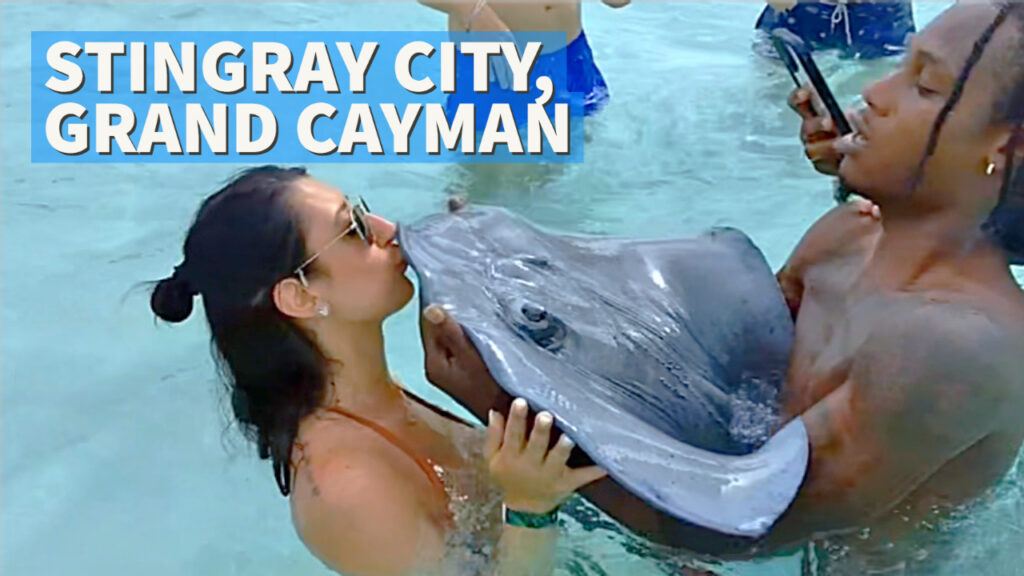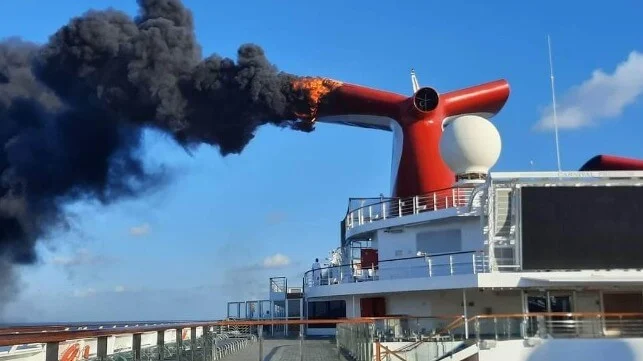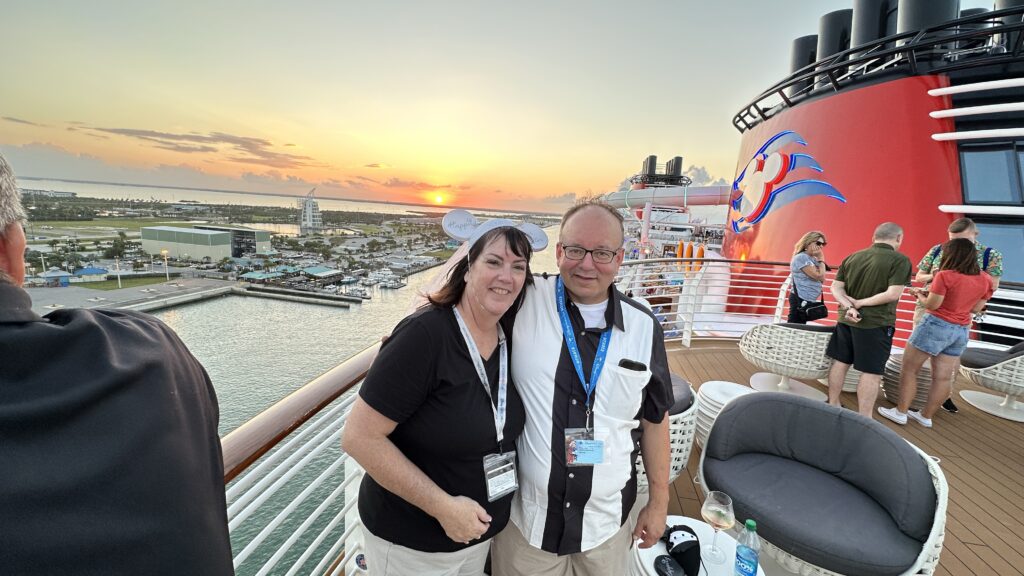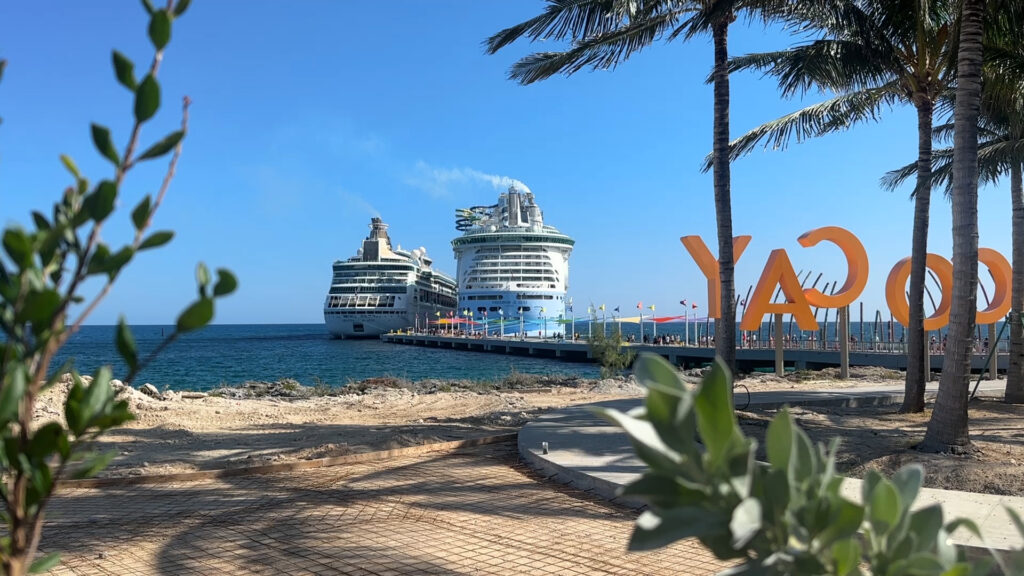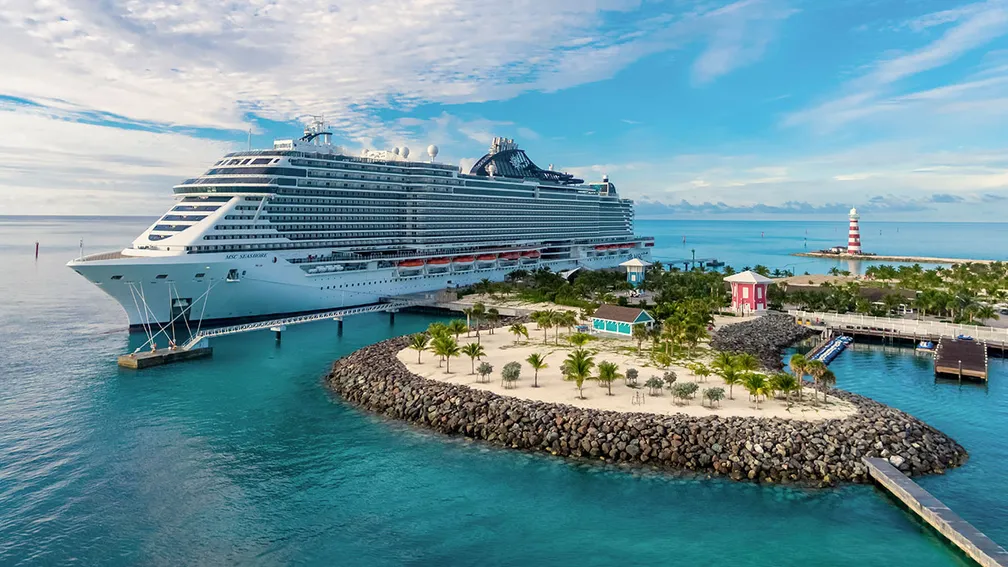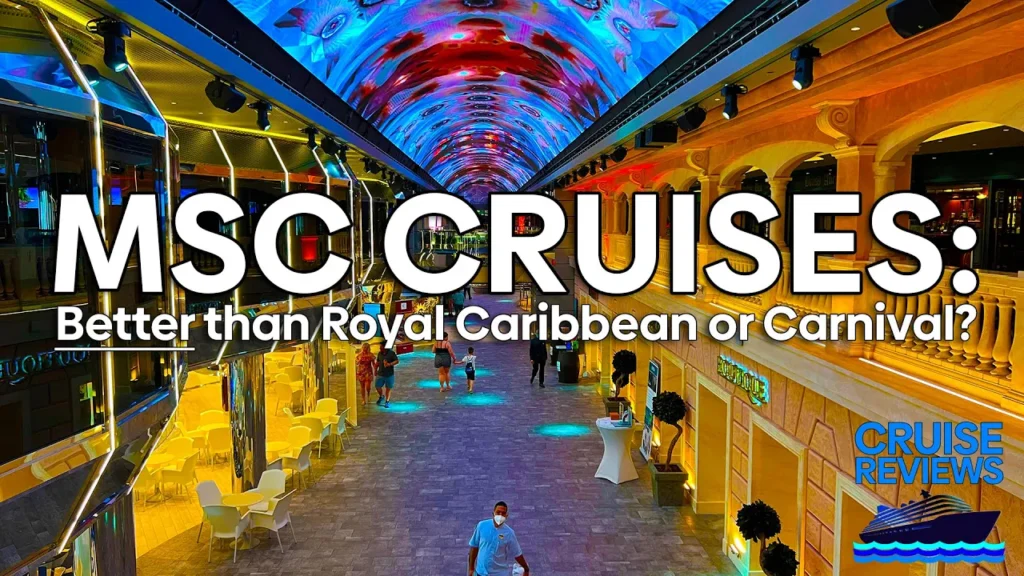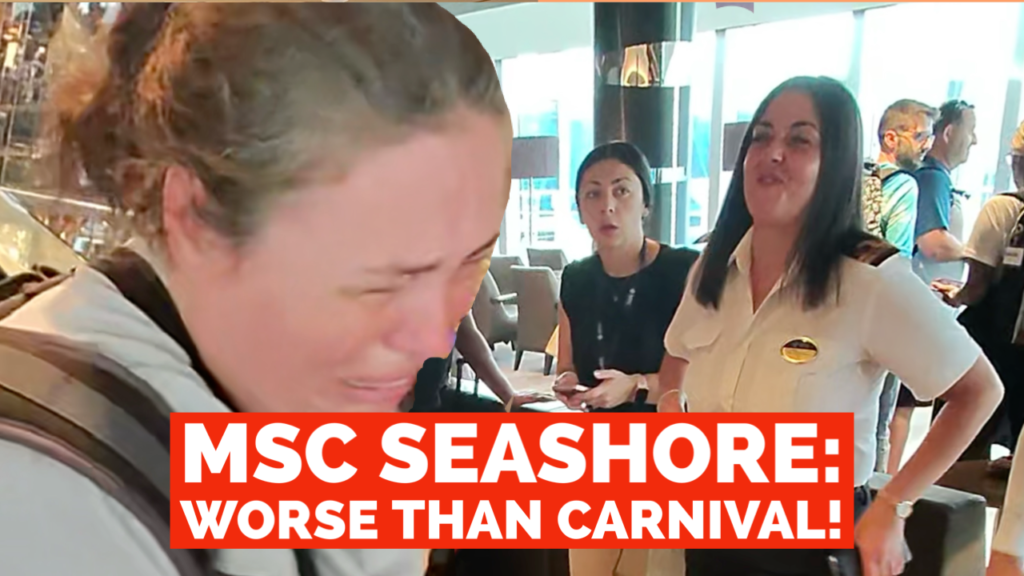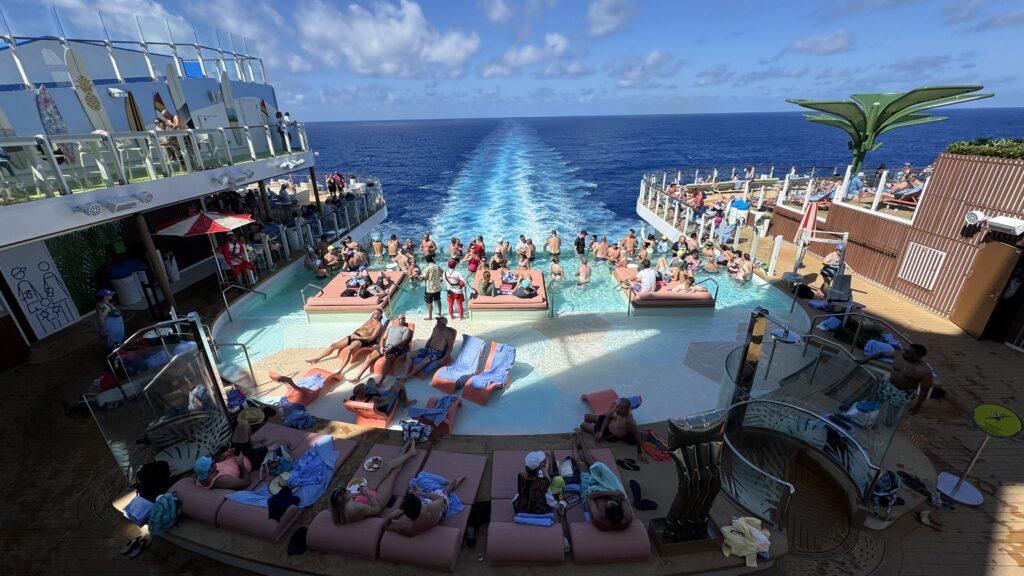Admiral Tim Cruise finally made it to Alaska, the final frontier. Yeah, it’s cold. It’s wet. Sea days are terribly boring. But his loyal troops asked him to go and report back what he thought, so he did. This blog breaks down why cruising is the go-to move for exploring at least a sliver of Alaska, the “Last Frontier,” without actually having to be a rugged frontiersman.
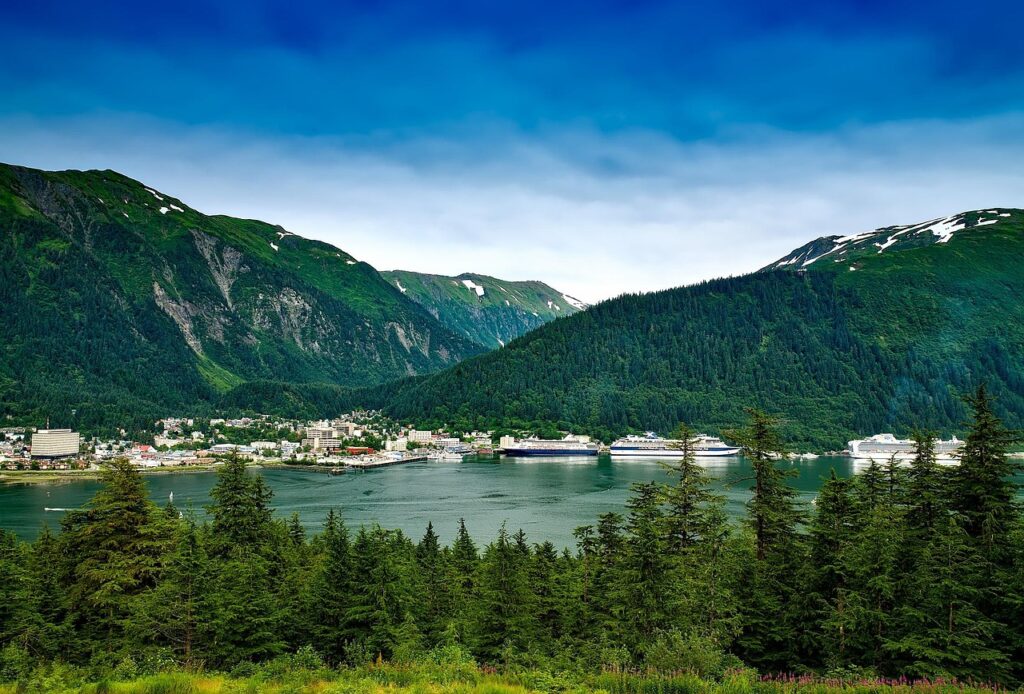
Look, I didn’t want to believe it, but Alaska cruises are a thing for a reason. They’re a shockingly efficient and affordable way to see breathtaking landscapes, tons of wildlife, and a bit of culture, all from the comfort of a “floating hotel” that does all the work for you. The main reasons people do this are: they want to see epic nature up close; and they hate planning, and they want to cram as much of Alaska as possible into one trip without breaking a sweat.
Everyone knows Alaska is a “bucket list” destination, mostly because it’s full of vast, untamed wilderness that wants to kill you. Its mountains are huge, its glaciers are actively falling apart, and its seas are no joke. Somehow, cruising has become the most popular way to see all this, offering a weirdly perfect mix of “I’m an adventurer!” and “Another tequila, please.”
Seriously, the Scenery is Ridiculous
The number one reason you’re going is to see glaciers and fjords, and you can do it right from the ship’s deck. This is the cruise’s trump card. You simply can’t get this view from a land tour unless you have your own boat and a death wish. The best stuff—tidewater glaciers and narrow fjords—is basically only accessible by ship.
- Glacier Bay National Park: This is the big one. It’s so important it’s a UNESCO World Heritage Site, which is fancy-speak for “don’t mess this up.” You get to see giants like the Margerie Glacier “calving”—where chunks of ice the size of a small building crash into the ocean. Only a few cruise lines, like Princess, are even allowed in, so it’s a pretty exclusive show. They’ll even put local park rangers on the ship to give you a play-by-play, so you can learn something while you watch nature’s demolition derby. Ranger on board? Sounds suspiciously like a mandatory safety brief, but with more geology.
- Hubbard Glacier: This is one of North America’s largest tidewater glaciers, a 76-mile-long monster that’s famous for its “jaw-dropping calving displays.” We’re talking ice chunks as tall as a 10-story building falling off. It’s also one of the few glaciers that’s still advancing, stubbornly refusing to just melt away like the rest.
- Tracy Arm & Endicott Arm Fjord: These are the narrow, dramatic fjords you see in pictures. You’ll sail through tight S-turns with 3,000-foot cliffs on either side, dodging massive icebergs. It feels like you’re on a real expedition, except you’re on a 15-story ship with a buffet.
- Inland Stuff: Cruises are also your gateway to the interior. A “cruisetour” add-on can get you to Denali National Park, home to the biggest mountain in North America and the “Big Five” land animals: grizzly bears, wolves, moose, caribou, and Dall sheep. It’s basically a checklist for your camera. You might even see the Northern Lights if you go late in season (but don’t bet on it).
Wildlife Spotting on Easy Mode
An Alaska cruise is basically a moving observation deck for spotting wildlife without having to sit quietly in the freezing mud for 12 hours. It’s the most efficient way to see animals in the water and on the land in a single trip.
The coastal waters are teeming with critters. Humpback whales are everywhere from May to September, breaching and doing whale things. Orcas (killer whales) cruise the Inside Passage. You’ll see so many harbor seals and sea lions lounging on ice floes that you’ll get tired of taking pictures of them. And yes, you can see bears (grizzly and black) right from the coastline, especially when the salmon are running in July and August. Bald eagles are so common they’re basically pigeons. But don’t try to feed them bread. Just don’t.
Your best bet for seeing all this is May through September. July is peak season—great weather, tons of animals, and tons of other tourists paying top dollar. May/June and September are cheaper and less crowded, but the weather’s a gamble. It’s the classic trade-off: your money versus your tolerance for crowds and cold. Here’s what you can see, and when’s the best time to see it.
Key Alaskan Wildlife and Optimal Viewing Times
| Wildlife Species | Optimal Viewing Months/Season | Key Locations/Notes |
|---|---|---|
| Humpback Whales | May – September (June/July optimal) | Prince William Sound, Glacier Bay National Park, Inside Passage, Juneau, Ketchikan, Sitka |
| Orcas (Killer Whales) | Early Summer (June – September) | Inside Passage, Glacier Bay, Kenai Fjords National Park (resident), Prince William Sound (resident) |
| Harbor Seals | Summer | Kenai Fjords, Prince William Sound, ice floes, rocky shores |
| Steller Sea Lions | Summer | Kenai Fjords, Prince William Sound, ice floes, rocky shores |
| Bald Eagles | Summer | Along the coast and near rivers, nesting and raising young |
| Grizzly/Black Bears | Late Spring – Early Fall (July/August ideal) | Along the coastline (especially during salmon runs), Katmai and Denali National Parks (via excursions) |
| Sea Otters | May – September | Kelp beds, coastal waters |
| Moose | Summer | More common inland, but may be seen grazing along shorelines |
| Puffins | Summer | Coastal cliffs |
| Dall’s Porpoise | Summer | Playing alongside boats in coastal waters |
| Caribou | Summer | Denali National Park (via cruisetour) |
| Dall Sheep | Summer | Denali National Park (via cruisetour) |
Ways to Empty Your Wallet on Shore (a.k.a. “Cruise Excursions”)
The shore excursions are where the real adventure (and spending) happens. The cruise ship is just your “base camp” for doing all the cool stuff you can’t do from the deck. You can go kayaking around glaciers, hiking in a rainforest, or ziplining over a canopy. You can also go fishing for giant salmon and halibut—some lines even have “Cook My Catch” programs where the onboard chefs will cook what you caught, which is a pretty solid flex. Or just take a flightseeing tour on a floatplane over places like Misty Fjords to get a view that’ll blow your mind, if you’re not blowing chunks as the pilot makes tight turns while showing off.
The true showstopper is dog sledding, which often involves taking a helicopter up to a glacier camp. Yes, you fly in a helicopter to go play with dogs on a glacier. It’s as awesome and expensive as it sounds. Or, you can opt for poor-man’s dog sledding, which is what we’re doing. Basically, it’s a team of huskies dragging a wheeled carriage in small yard. Yeah, it’s as ghetto as it sounds.
Buyer Beware
I know you’ve been itching to bust out those REI snow shoes and trendy fur parka. But the truth is most mainstream (Royal, NCL, Princess) Alaskan cruises don’t get into the REAL Alaska – meaning more Arctic destinations like Anchorage, Kodiak Island, Denali, or anywhere even remotely close to the Bering Sea. Chances are you won’t be able to see into Russia from your backyard since you’re most likely hanging around the southeastern area of Alaska, known as the Alaskan Panhandle. This name comes from its distinct shape—a long, narrow strip of land and islands that extends south from the main part of the state, sharing a long border with Canada.
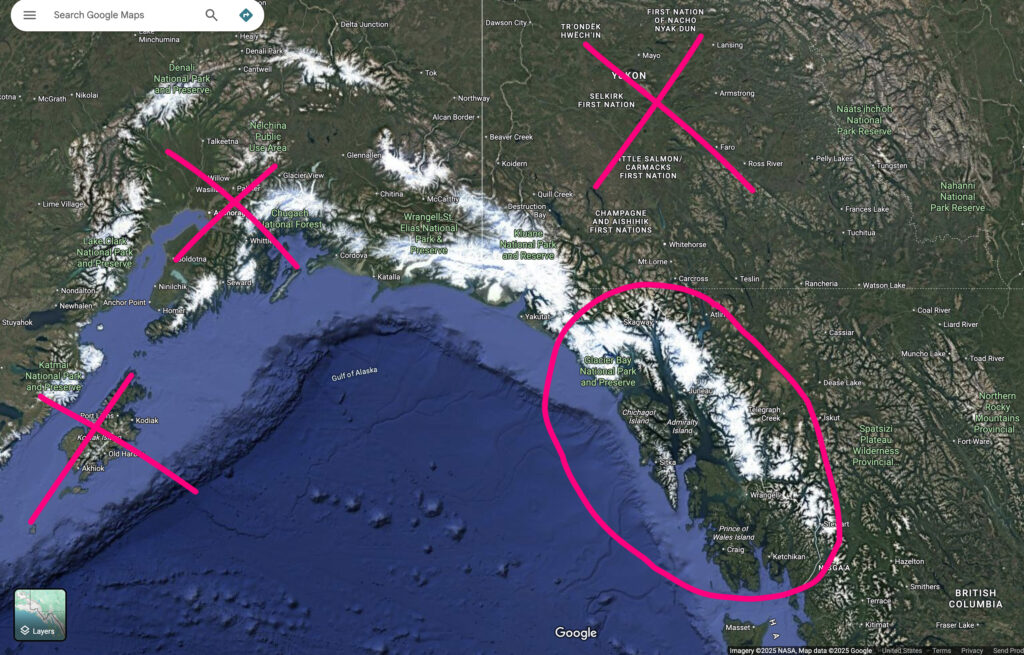
You will also frequently hear the region referred to as the Inside Passage. While the Panhandle refers to the land itself, the Inside Passage is the network of fjords, straits, and waterways that weaves between the mainland and the thousands of islands of the Alexander Archipelago. This sheltered marine highway is the primary route for ferries and the many cruise ships that visit the area’s famous towns, including Juneau, Ketchikan, Skagway, and Sitka.
So yeah, you’re not really going anywhere near icebergs or indigenous folk, so get that beautiful Hollywood illusion out of your head. Unless you’ve booked the cruisetour option that includes travel by train or bus, basically, you’re sailing around Western Canada’s beach towns, which have been located in an American state since 1959. Russia sold Alaska to the United States for just over seven million dollars in 1867, believing the United States would help counter Russia’s greatest rival in the Pacific at that time, Great Britain. Whoops.
Oh, and sorry, Virginia, North Pole, Alaska, although it’s a schmaltzy tourist destination, is inaccessible by cruises as it’s landlocked in central Alaska somewhere near Fairbanks. The legit North Pole lies somewhere in the middle of the Arctic Ocean. And it’s actually moving 25-30 miles a year towards Siberia. Santa Claus probably moved his elves to China not long after the sequel to Bad Santa was released.
Quick and Dirty History Lesson
Believe it or not, there’s culture here, too. The cruise ports are a highlight reel of Alaska’s history. Since some towns like Juneau (the state capital) are only accessible by sea or air, the cruise ship is your chariot. The whole itinerary is a “cultural corridor,” which is a fancy way of saying you can sample a bunch of different towns without having to drive.
- Ketchikan: “Salmon Capital of the World.” Famous for its massive collection of totem poles and the historic, and formerly very sketchy, Creek Street.
- Skagway: This whole town is basically a monument to the Klondike Gold Rush. You can ride a historic railway and pretend you’re a grizzled prospector from 1898.
- Icy Strait Point: A historic salmon cannery next to Hoonah, the largest Alaska Native Tlingit village. It’s owned and operated by Natives, so the experience is authentic (and the zipline is amazing).
- Sitka: A weird mix of Alaska Native and Russian history. You can see onion-domed churches and totem poles in the same town.
Popular Ports of Call and Their Unique Cultural/Historical Highlights
| Port Name | Primary Cultural/Historical Focus | Key Attractions/Experiences |
|---|---|---|
| Ketchikan | Alaska Native Culture, Gold Rush History | World’s largest collection of totem poles, Creek Street, Saxman Native Village, Tongass Historical Museum |
| Juneau | Gold Rush History, Tlingit Culture, State Capital | Mendenhall Glacier, whale watching, city tours, gold panning, cultural centers, museums |
| Skagway | Klondike Gold Rush Legacy | White Pass & Yukon Route Railroad, Klondike Gold Rush National Historical Park, dog sledding, gold panning |
| Icy Strait Point | Alaska Native Tlingit Culture | Historic salmon cannery, Tlingit cultural experiences, Hoonah village |
| Sitka | Alaska Native & Russian History | Sitka National Historical Park, Fortress of the Bear, Raptor Center, cultural song and dance performances |
| Wrangell | Tlingit Culture, Historical Significance | Tlingit cultural sites, Petroglyph Beach State Historic Park, only town under three flags/four nations |
| Petersburg | Norwegian Heritage, Fishing Industry | Scenic waterfront, art galleries, museums, commercial fishing port |
| Kake | Tlingit Heritage | One of the tallest totem poles in the world (132 feet), Tlingit song and dance demonstrations |
| Haines | Tlingit Culture, Bald Eagle Preserve | Chilkat Bald Eagle Preserve, Tlingit cultural experiences, local distillery |
The Big Decision: Cruise vs. Land Tour
So, what’s better? A cruise or a land tour? It depends on how much of Alaska you want to see, how long you have before you need to get back to work, and how much you’re willing to spend.
- Cruise: Unbeatable for coastal mountains, tidewater glaciers, and marine wildlife (whales, seals, etc.). You see all the famous coastal towns. It’s the classic, low-effort, high-reward Alaska experience.
- Land Tour: Essential if you want to see the interior—especially Mt. Denali and the “Big Five” land animals. You have more flexibility but you’re also doing all the work: driving, booking, and planning.
The ultimate move? The “Cruisetour.” You do a 7-night cruise along the coast, then you hop on a train or bus for a few days to go inland and see Denali. It’s the most comprehensive way to do Alaska, combining the best of both worlds.
Comparison: Alaska Cruise vs. Land Tour
| Feature | Alaska Cruise Benefits/Characteristics | Land Tour Benefits/Characteristics | Limitations/Considerations |
|---|---|---|---|
| Access to Coastal Wonders (Glaciers, Marine Wildlife) | Excellent; direct access to tidewater glaciers, fjords, and marine life. | Limited to specific coastal points; less direct marine wildlife viewing. | Cruises cannot venture far inland. |
| Access to Interior (Denali, Land Mammals) | Limited; typically requires a “cruisetour” extension. | Essential; allows deep exploration of national parks and land mammal habitats. | Land tours miss extensive marine views. |
| Planning Effort | Low stress; logistics (attractions, transport, accommodation) handled by cruise line. | High effort; requires extensive self-planning for accommodation and transport. | Cruises offer less control in port. |
| Cost Predictability | More inclusive fee structure; exact spending known upfront. | Variable costs; customizable spending but less predictable. | Excursions on both can add significant cost. |
| Group Travel Suitability | Ideal; accommodates large groups without individual coordination. | Challenging for large groups; tour capacities may be limited. | |
| Flexibility/Control | Less flexible; set schedule in port. | More flexible; allows exploration at own pace. | |
| Primary Vantage Point | Ocean-focused; coastal views. | Land-focused; interior landscapes. |
The “Floating Hotel” Advantage
Let’s be honest: a huge reason to do this is the sheer convenience. It’s “effortless exploration.” If you hate planning, coordinating, and worrying about logistics, this is for you. The cruise line does everything. You just show up. No booking 5 different hotels, being strong armed into rental car insurance, and playing fish roulette trying to guess where to eat, and where not to eat. Plus, the costs are mostly bundled, so you know what you’re spending upfront. It makes a “bucket list” trip accessible to people who’d otherwise be too intimidated to plan it. It’s also perfect for big groups, because trying to coordinate a land tour for 12 of your relatives is a special kind of hell.
The Ship is Half the Destination
The ship isn’t just your ride; it’s a “dual destination.” You’re paying for Alaska, and you’re paying for a luxury resort experience at the same time. You can watch a glacier calve from your private balcony. You can eat gourmet seafood while sailing through a fjord. You’ve got spas, pools, gyms, casinos, and live shows. It’s the perfect way to feel rugged and adventurous during the day and completely pampered at night.
When Should I Cruise To Alaska?
The cruise season is basically May to September. Your timing is critical.
- July: Peak season. Best weather, most wildlife activity. Also the highest prices and biggest crowds.
- June & August: Still high season. Great weather and wildlife, slightly fewer people than July. We headed up in August.
- May & September (Shoulder Season): The bargain hunter’s choice. Fewer crowds, lower prices. Most of the parasitic children have gone back to school, so no one will be kicking your door at 3 AM and running. Weather is a crapshoot—it can be beautiful or it can be cold and rainy. You might see the Northern Lights in late September if you’re lucky.
Cruises become rare and expensive outside of September to May. Think small icebreaker ships with rugged crew, high seas, and wild rugged explorer types with more money than brains.
Here’s what to expect weather-wise at some popular Alaska cruise ports.
Ketchikan’s Climate: A Look at Average Temperatures and Rainfall Year-Round
Ketchikan, Alaska, is characterized by a cool, temperate maritime climate that brings mild winters, cool summers, and a significant amount of rainfall throughout the year. The average annual temperature hovers around 46°F (8°C), and the city receives an impressive average of over 150 inches of rain annually, earning it the nickname “Rain Capital of Alaska.”
The warmest months are typically July and August, with an average high temperature around 64°F (18°C) and an average low of 53°F (12°C). These summer months, which also see the least amount of rainfall, provide the most pleasant weather for outdoor pursuits and mark the peak of the tourist season.
Conversely, January is the coldest month, with an average high of 39°F (4°C) and an average low of 32°F (0°C). While temperatures can dip to freezing, the moderating influence of the ocean prevents the extreme cold experienced in other parts of Alaska. The autumn and winter months see a substantial increase in precipitation, with October being the wettest month.
Here is a monthly breakdown of the average high and low temperatures, along with the average rainfall in Ketchikan:
| Month | Average High (°F) | Average Low (°F) | Average Rainfall (inches) |
| January | 39 | 32 | 13.70 |
| February | 41 | 31 | 12.68 |
| March | 44 | 32 | 10.82 |
| April | 50 | 37 | 10.95 |
| May | 57 | 43 | 9.51 |
| June | 61 | 49 | 7.36 |
| July | 64 | 53 | 7.37 |
| August | 64 | 53 | 10.89 |
| September | 59 | 48 | 14.13 |
| October | 51 | 41 | 21.88 |
| November | 44 | 35 | 17.31 |
| December | 40 | 32 | 15.78 |
Juneau’s Climate: A Blend of Mild Temperatures and Substantial Rainfall
Juneau, the capital of Alaska, is nestled in a subarctic maritime climate zone, resulting in winters that are milder than much of the state and cool, moist summers. The city’s weather is heavily influenced by the Pacific Ocean, which moderates temperatures year-round. The average annual temperature in Juneau is approximately 42°F (5.6°C).
The warmest period in Juneau occurs in July and August, with average high temperatures reaching around 64°F (18°C) and lows near 51°F (11°C). These summer months offer long days of daylight, perfect for exploring the stunning natural surroundings.
Winter in Juneau is chilly and damp, with January being the coldest month. The average high in January is about 33°F (0.6°C), and the average low dips to around 25°F (-4°C). While snowfall is common, with an annual average of about 88 inches, the coastal location prevents the extreme and prolonged cold found in interior Alaska. Juneau is also known for its significant precipitation, which is spread throughout the year but peaks in the fall. The city receives an average of over 62 inches of precipitation annually.
Port stops in Juneau may be limited or missing in 2026 sailings. Royal Caribbean sent a note to folks already booked that Juneau will be skipped. It read: “Due to port availability changes in Juneau, Alaska, we’ll now enjoy a visit to Ketchikan, Alaska, instead and then travel onto Sitka, Alaska, the next day.”
Royal Caribbean has not provided any further details other than “port availability changes” as to why Juneau has now been dropped from the various itineraries. Officials in Juneau unanimously approved increasing dockage fees on cruise lines, changing the fee structure from a vessel’s gross tonnage to its passenger capacity. As these fees directly offset profit, port increases may influence cruise lines’ operational plans.
Cruise news sources report that Royal Caribbean is planning a new private destination on Douglas Island, just across the Gastineau Channel from the city of Juneau, scheduled to be completed sometime in 2027. This private port would not be subject to the increased fees, yet is conveniently located to permit visitors to enjoy many of the same shore tour opportunities and local attractions.
If you’re lucky enough to get to Juneau before the change, here is a monthly look at the average temperatures and rainfall in Juneau:
| Month | Average High (°F) | Average Low (°F) | Average Rainfall (inches) |
| January | 33 | 25 | 5.35 |
| February | 35 | 25 | 4.13 |
| March | 40 | 28 | 3.78 |
| April | 48 | 33 | 2.94 |
| May | 57 | 41 | 3.40 |
| June | 62 | 47 | 3.24 |
| July | 64 | 51 | 4.60 |
| August | 63 | 49 | 5.73 |
| September | 56 | 44 | 8.64 |
| October | 47 | 38 | 8.63 |
| November | 38 | 29 | 5.99 |
| December | 34 | 26 | 5.84 |
Skagway’s Climate: A Drier and More Extreme Alaskan Panhandle Experience
Skagway, Alaska, located at the northern end of the Lynn Canal, has a climate that is distinct from its Southeast Alaskan neighbors like Juneau and Ketchikan. Due to its position in a long, narrow valley, it experiences a drier climate with more pronounced temperature extremes. Skagway is in a “rain shadow,” created by the surrounding high mountains, which results in significantly less precipitation than other towns in the region. The average annual temperature is about 41°F (5°C).
Summers in Skagway are pleasant and mild. The warmest month is July, with an average high temperature of around 65°F (18°C) and an average low of 51°F (11°C). The long daylight hours during this period make it ideal for tourism and outdoor activities like hiking the famous Chilkoot Trail.
Winters are colder and snowier than in other coastal towns in the panhandle. January is the coldest month, with an average high of 29°F (-2°C) and an average low dropping to 19°F (-7°C). The drier air allows for colder temperatures than in the rain-soaked southern parts of the region.
Here is a monthly breakdown of the average temperatures and precipitation for Skagway:
| Month | Average High (°F) | Average Low (°F) | Average Precipitation (inches) |
| January | 29 | 19 | 2.24 |
| February | 32 | 20 | 1.63 |
| March | 39 | 25 | 1.40 |
| April | 49 | 32 | 1.13 |
| May | 58 | 40 | 1.19 |
| June | 64 | 47 | 1.39 |
| July | 65 | 51 | 1.83 |
| August | 63 | 49 | 2.50 |
| September | 56 | 43 | 4.29 |
| October | 46 | 36 | 4.29 |
| November | 36 | 27 | 2.76 |
| December | 30 | 21 | 2.55 |
Note: “Precipitation” includes both rainfall and the liquid equivalent of snowfall.
Sitka’s Climate: Mild, Wet, and Oceanic
Sitka, Alaska, located on the west coast of Baranof Island, is fully exposed to the Pacific Ocean, which gives it a classic and pronounced maritime climate. This results in very mild winters for its latitude and cool, moist summers. The oceanic influence keeps temperatures from dropping to the extreme lows seen in the interior and even in other Southeast Alaskan towns. The average annual temperature in Sitka is approximately 45°F (7.2°C).
Summers in Sitka are cool and generally overcast. The warmest month is August, which has an average high of around 62°F (17°C) and an average low of 52°F (11°C).
Winters are remarkably mild but very wet. January is the coldest month, but with an average high of 40°F (4.4°C) and an average low of 33°F (0.6°C), temperatures hover near the freezing point. Significant snowfall can occur, but it’s often interspersed with rain, and the snowpack at sea level may not last all winter.
Sitka receives a great deal of precipitation, averaging around 86 inches annually. The rainfall is spread throughout the year but, like its neighbors, sees a significant increase in the fall, with October being the wettest month.
Here is a monthly breakdown of the average temperatures and precipitation for Sitka:
| Month | Average High (°F) | Average Low (°F) | Average Precipitation (inches) |
| January | 40 | 33 | 8.19 |
| February | 41 | 33 | 6.22 |
| March | 43 | 34 | 5.48 |
| April | 49 | 38 | 4.60 |
| May | 55 | 44 | 3.82 |
| June | 59 | 49 | 3.25 |
| July | 62 | 53 | 4.41 |
| August | 62 | 52 | 6.43 |
| September | 58 | 48 | 10.36 |
| October | 50 | 42 | 12.35 |
| November | 44 | 36 | 10.15 |
| December | 41 | 34 | 9.06 |
Note: “Precipitation” includes both rainfall and the liquid equivalent of snowfall.
How Should I Pack For Alaska?
Just like we learned when we went to Iceland last year, packing for any northern expedition, including Alaska cruises, is all about smart layering and being prepared for a wide range of conditions, often on the same day. The key is to stay warm, dry, and comfortable whether you’re whale watching from the deck or hiking near a glacier. Here’s a comprehensive guide on how to pack.
The Golden Rule: Layers
Alaskan weather is famously unpredictable. You could experience sunshine, rain, wind, and chilly temperatures all in a single afternoon. Layering your clothing is the most effective strategy to adapt.
- Base Layer: Start with moisture-wicking short and long-sleeved shirts. Materials like merino wool or synthetic fabrics are ideal because they draw sweat away from your skin, keeping you dry and warm.
- Mid-Layer: This is your insulation layer. Think fleece jackets, puffy vests, or cozy sweaters. These pieces trap heat and are easy to remove if the sun comes out.
- Outer Layer: This is your shield against the elements. A high-quality, waterproof, and windproof jacket with a hood is non-negotiable. This will be your most important piece of clothing for staying comfortable during onshore excursions and on windy ship decks.
Essential Clothing Checklist
For Onshore Adventures and Deck Viewing:
- Waterproof Jacket: A must-have for rain and wind.
- Fleece or Puffy Jacket/Vest: For warmth under your shell.
- Long-Sleeved and Short-Sleeved T-shirts: For your base layers.
- Pants:
- Water-resistant hiking pants: Essential for active excursions.
- Jeans or comfortable casual pants: Fine for drier days in port or around the ship.
- Socks: Pack several pairs of wool or synthetic moisture-wicking socks to keep your feet warm and dry.
- Footwear:
- Waterproof hiking boots or shoes: Crucial for shore excursions to keep your feet dry and supported on uneven terrain.
- Comfortable walking shoes: For exploring towns or for days on the ship.
- Accessories:
- Warm Hat and Gloves/Mittens: You will be glad you have these, especially during glacier viewing or on boat excursions.
- Scarf or Neck Gaiter: Adds an extra layer of warmth and protection from the wind.
- Sunglasses: The sun can be surprisingly strong, especially reflecting off water and ice.
For Onboard the Ship:
- Casual Daywear: Jeans, leggings, sweaters, and comfortable shirts are perfect for relaxing on the ship.
- Dinner Attire:
- Smart Casual: Most nights in the main dining rooms will have a “smart casual” dress code. For men, this means pants or nice jeans with a collared or sport shirt. For women, a dress, skirt, pants, or nice jeans with a stylish top is appropriate. But no one really cares anymore.
- Formal/Chic Nights: Most cruises will have one or two formal or “evening chic” nights, depending on the length of the voyage. This calls for cocktail dresses, gowns, or elegant pantsuits for women, and suits, or a sport coat and dress pants for men. Dressing up is completely optional.
- Swimsuit: Don’t forget this! The ship will have heated pools and hot tubs, which are fantastic to use, especially with the stunning scenery around you.
- Workout Clothes: If you plan on using the fitness center.
- Comfortable Shoes/Slippers: For relaxing in your cabin. Or just don’t wear anything.
Essential Non-Clothing Items
- Backpack or Daypack: A waterproof bag is ideal for carrying your layers, camera, water bottle, and other essentials on shore excursions.
- Binoculars: A must-have for wildlife viewing. You’ll be able to spot whales, bears, eagles, and more from a distance.
- Camera and Accessories: Bring extra batteries and memory cards. A tripod can be useful for capturing the Northern Lights if you’re traveling late in the season.
- Sunscreen and Lip Balm with SPF: The sun reflecting off the water and glaciers can cause sunburn, even on cloudy days.
- Insect Repellent: Especially for onshore excursions in forested areas. Some of those mosquitoes are the size of pigeons!
- Reusable Water Bottle: Stay hydrated during your adventures. Or drink beer. I don’t care.
- Medications: Pack any prescription medications and a small first-aid kit with basics like pain relievers and bandages.
- Travel Documents: Don’t forget your passport (as many cruises stop in Canada), driver’s license, and cruise documents.
- Portable Charger/Power Bank: To keep your devices charged while you’re out and about. But beware of new airline size limitations.
- Sleep Mask: Helpful during the summer months when you’ll experience the “midnight sun” and extended daylight hours.
The Verdict on Alaska Cruises
People choose an Alaska cruise because it’s a brilliant package deal: you get world-class nature, wildlife, and culture delivered straight to your door with all the comfort and convenience of a resort. The geography of Alaska’s coast makes a ship the best, and sometimes only, way to see its most iconic sights. It minimizes the logistical headaches and lets you focus on the good stuff.
While a cruise nails the coast, if you want the full Alaskan experience, tack on a land tour. The “cruise tour” is the gold standard. Ultimately, a cruise is the most effective and, let’s face it, enjoyable way for most people to experience the absolute grandeur of the Last Frontier.
We’ll report back here and update when we return.

